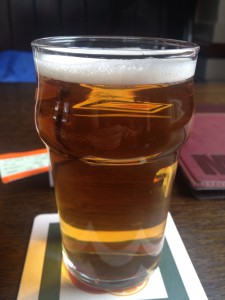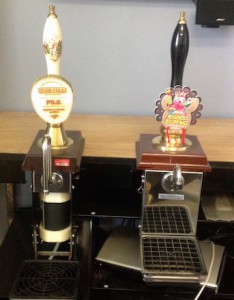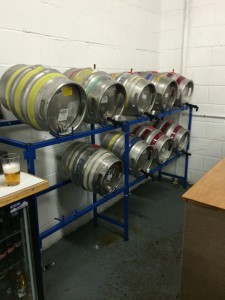Real Ale is not a beer style, it is almost a method of dispensing beer, Almost.
From Randy Mosher’s book Tasting Beer: chapter three “Real ale casks are delivered to the pub still fermenting. It is the publican’s duty to manage this process and determine when the beer is fit to serve. This is a challenging process, but aficionados feel the challenges and short shelf life are worth the extraordinary texture and subtle flavors of real ale….” (This is a great book to read for anyone who wants to learn about all beer).
As with all beer, once brewed, it lacks carbonation (or at least the carbonation level that is in the beer when served). In order to carbonate the beer, the beer is placed in a cask along with some finings (things to help clarity the beer). It ferments a second time and creates CO2, carbonating the liquid. How does it do this you might ask? The brewery stops the primary fermentation just before all of the sugars are consumed. There is yeast still present in the beer so after it is placed in the cask and sealed, everything is present to have a secondary fermentation. This secondary fermentation starts when the cellar man works his magic on it. Real Ale is a beer that is served from the container that this secondary fermentation occurs in. It is made from traditional ingredients, served at temperatures between 50f and 55f (10C-12C) carbonated at the lower end of the spectrum than most beers, but it isn’t flat, it’s lightly carbonated. It is never dispensed by pushing it with CO2 (as kegged beer is).
It is usually gravity dispensed from the cask or the cask is hooked to a hand pull otherwise known as a beer engine. A beer engine ‘pulls’ the beer out of the cask. When using a hand pull, the cask is out of sight under the bar or in a back refrigeration area. When gravity dispensed the cask can be on the bar or behind the bar area on racks.
The beer that comes out of the cask or beer engine is almost always clear, in fact the English term is ‘dropped bright’ referring to the fact that the particulate matter has dropped out of the beer solution.
The clarity of the beer is not due to filtering. It is entirely from the bar or breweries actions mentioned in Randy’s quote above. The correct term for this action is called cellaring. It is an action that most American brewers and brewpubs have yet to understand.
It can be many different beer styles, bitters, pale ales, IPAs, Scottish ale, porters,and stouts, to name a few. It is usually not a big beer meaning that the alcohol level is between 2.x to 6 abv, there are some exceptions. Some of the finest real ales I’ve had were under 4% abv.
If you notice in the photo to the left, The top of the cask has a small piece of wood sticking out of it. It is there for a reason. Visit this page if you’d like to know more. When you dispense beer from a cask, outside air has to be let into the cask to allow the beer to flow freely out of the cask. Over time, this outside air which has airborne bacteria, will cause the beer to go foul. Hopefully you have had enough beer drinkers to go through the beer before this happens. This means that a cask doesn’t have much of a life span, 3-4 days normally. There are some methods of allowing CO2 to be pulled in instead of outside air and this with extend the life span of the cask a bit.
The great thing about real ale is that it really showcases fresh beer’s window of best enjoyment. All beer has a time frame that shows off its’ best attributes. The more alcohol in a beer, the longer it takes to get to this sweet spot. All beer has a time when it is extremely fresh, we call this green. It also has a time after this best window and the beer tastes old. The hoppy aromas and flavors drop off, a sometimes cardboard-y flavor sets in and bitterness can seem exaggerated.
This is why I think big beers (high alcohol) don’t really work with real ale. The time it takes to get into the sweet spot of a big beer is a long time. Except for the occasional special cask, breweries can’t afford to have their cask tied up doing nothing but sitting there for weeks or months. Lower alcohol beers work best with real ale because they come to ready quicker. Not to mention the beauty of brewing a beer with lower alcohol on purpose and paying attention to having it be a full flavored beer.
Find some place that serves real ale and try it, but be wary of the fact that just because there’s a cask sitting on a bar, doesn’t mean you are really getting to taste real ale. We tend to cheat in the US of A and use the cask as a marketing ploy.



You must be logged in to post a comment.